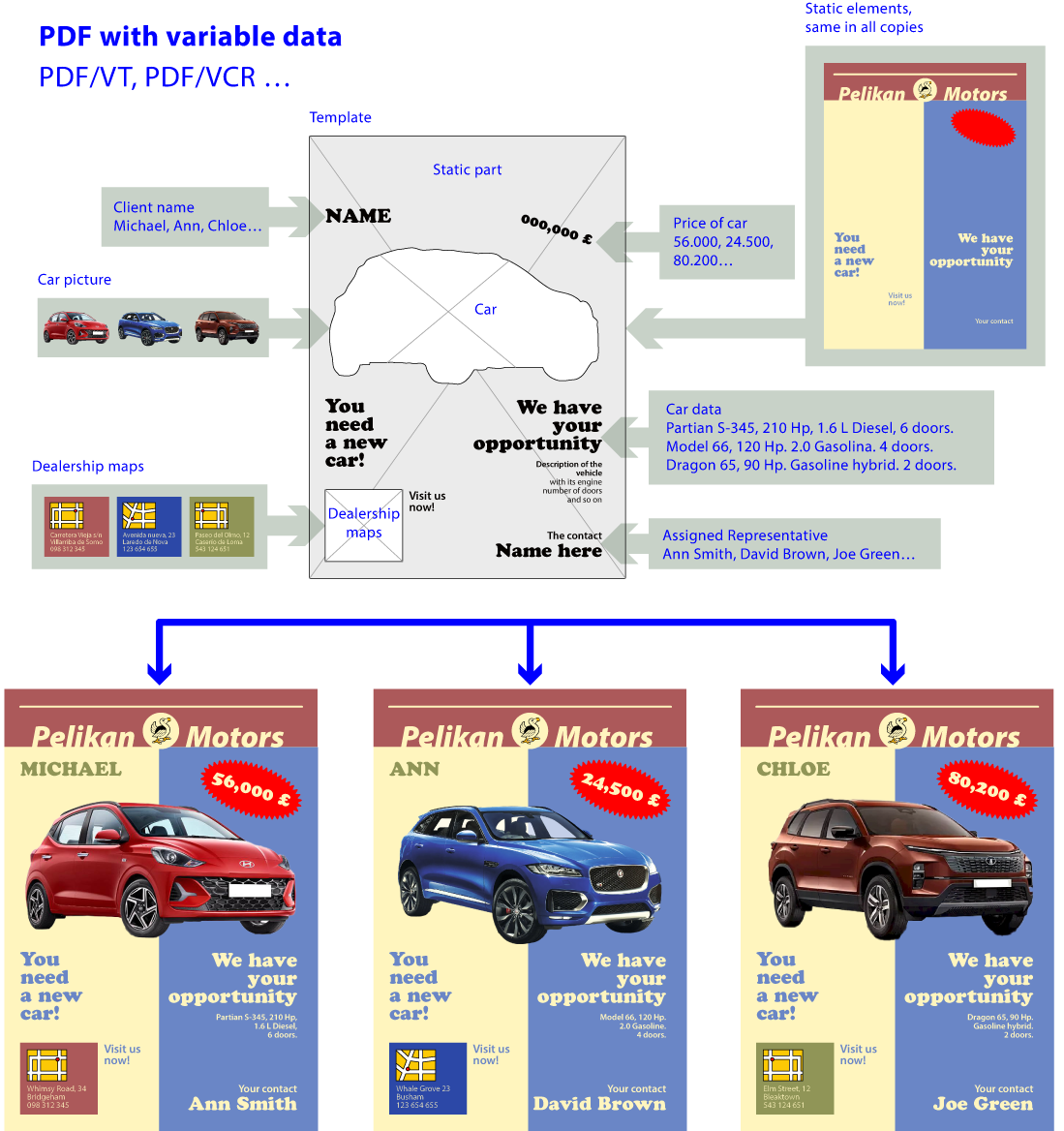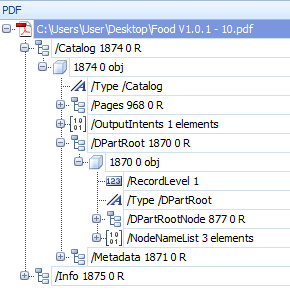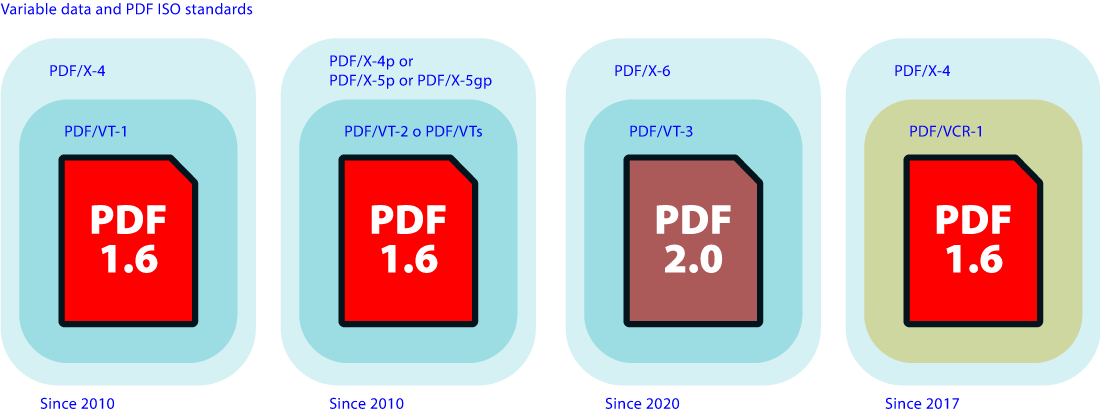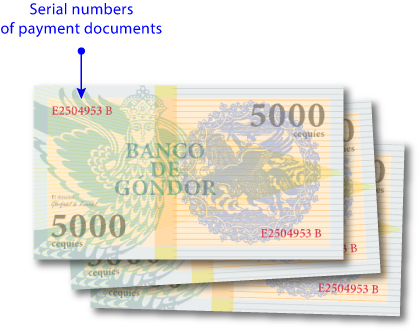Variable data are data that change from one printed copy to the next, while the surrounding data remain unaltered. A typical case, for example, is the preparation of thousands of business letters, each with a different user name and address.
The use of the PDF format significantly improves the printing of variable data as it allows the creation of easily accessible or printable colour documents with a very high visual quality.
Besides, the standardisation of the use of variable data with PDF, a publicly known and established format, eases the interaction of machinery and software from different manufacturers that until now used their own proprietary formats.

Above we can see an example of the possibilities of using variable data with PDF format: A car dealer combines his databases of potential customers and available vehicles to create targeted advertisements in which a customer is offered a specific vehicle and an appointment at a specific location with an assigned representative.
To create these documents, we must use a software capable of merging all the elements. Once the PDF is created, all we need is a digital printer with quality enough to print and insert in its envelope each copy. The ubiquity and popularity of the PDF format makes the latter much easier.
Ways to combine PDF and variable data
There are two main approaches in the use of variable data with PDF standards. Each has its advantages and disadvantages. In both cases, variable data are treated or identified in a special way. they are not just static data, like those parts of the document that do not change from copy to copy.
Include variable data inside the document
Here the final content is included in its entirety in the PDF. The merging of the variable data and the static parts takes place when the PDF is created. It has the same pages with different data included as many times as necessary for the print run and each part is identified at the machine with the appropriate metadata so that the device can handle it correctly.

This type of PDF, which includes all the content, is not a static PDF, as the variable data, identified with metadata, can be extracted and changed.
One advantage of this approach is that the resulting PDF can be printed on any device, although those prepared for this type of metadata speed up rasterisation and can automatically deal with many documents faster and easier.
In the standards, this approach is that o PDF/VT (where the whole PDF document with all the data must be fully generated before rasterisation begins, even in PDF/VT-2).
Call external data when printing the document
Here, the variable data are merged with the rest of the design using PDF format at the time of printing. The result is rasterised on the device but not saved.

Each document is a kind of template that includes only the pages required for one copy and the data are injected into its location applying the specified format when rasterised on the device printing engine. The variable data and all the parameters necessary for the operation are identified by metadata.
In the standards, this is the approach of PDF/VCR.
DPart metadata
The basis for the use of variable data are some metadata structures called "Document Part Metadata"; that is, data relating to pages and groups of pages.
These metadata are organised hierarchically in a tree of pages or sets of pages, which form parts called "Data Parts" (DParts), which can carry their metadata (DPM: Document Part Metadata).

These metadata do not only refer to content (such as proper names or postal addresses, as in traditional mail merges), but they are also used to specify different parameters of reproduction for these groups of pages (paper kind, page format, etc.).

These structures contain three types of elements:
- "
DPartRoot": A root dictionary called "DPartRoot", on which the other DPart metadata nodes hang and which must be referenced directly in the "Catalog" dictionary. - "
dparts": Groups of one or more pages of the document. They must have start and end identifiers. There must be at least one (though there can be more). - "
dpm": A dictionary containing the metadata themselves (tha is: the values). There must be at least one, associated with a "dpart".
PDF/VT
PDF/VT is the first standard (created by ISO in 2010) for the reproduction of variable data with PDF for printing. Its original use is intended for the printing of transactional variable data (hence the acronym VT: Variable and Transactional Printing); that is: Commercial transactions such as invoices, delivery notes, quotations and personalised mail, etc.
It is a substandard of PDF/X. Its use does not preclude a document from being PDF/X (in fact, it must be at least PDF/X-4).
PDF/VT is especially intended to be used with JDF job definition documents and the systems and methods developed by the CIP4 organisation for the automation in printed graphic arts.
The use of the most advanced versions (i.e. higher than version 2.5) of Adobe's PDF Print Engine is what makes it possible to print large volumes of such PDF/VT documents very fast and reliably, as the final rasterisation of the data (in properly prepared documents) is very efficient.
PDF/VT currently has three variants:
PDF/VT-1 and PDF/VT-2: Both are defined by the same standard (ISO 16612-2:2010). Version 1 refers to the use with PDF/X-4 and version 2 with PDF/4p, PDF/X-5g and PDF/X-5pg. Both are based on PDF level 1.6.
With PDF/VT-1 variable data and static data (the layout) go together in the same document. Everything is a single file that contains all that is needed for its reproduction (there's no call to external data of any kind).
In PDF/VT-2, reference to external objects (colour profiles and data) is supported. In fact, it has a PDF/VT-2s subvariant that supports calling them in batches of data streams.
This is designed to ease the use of large datasets, either in aggregate or in successive calls.
- PDF/VT-3: It is defined for the use of variable data with PDF/X-6 (ISO 16612-3:2020) and it is based on the use of PDF level 2.0 (ISO 32000-2:2020), which already includes DPart Metadata as an integral part of the PDF format (which was not the case in level 1.6).

PDF/VCR
In 2017, ISO created the PDF/VCR-1 standard for Variable Content Replacement (VCR).
In PDF/VCR-1, single or multipage templates with static data and design and variable content placeholders are created. The variable data are feed to the device in a comma-separated value (CSV) format at the time of printing, which assembles the PDF on the fly, without having to save a copy of the PDF.

This method is very useful in systems where high print quality (provided by the PDF format) is needed but we do not want to save the files for the printout; for instance credit cards with different numbers and PIN codes, pharmaceutical packaging with batch and serial numbers generated from sensors, serial numbers of banknotes, etc.
Defining standards
PDF/VT-1, PDF/VT-2 and PDF/VT-2s are specified in the standard ISO 16612-2:2010.
PDF/VCR-1 is specified in the standard ISO 16613-1:2017.
PDF/VT-3 is specified in the standard ISO 16612-3:2020.
[© Gustavo Sánchez Muñoz, 2025] Gustavo Sánchez Muñoz (also identified as Gusgsm) is the author of the content of this page. Its graphic and written content can be shared, copied and redistributed in whole or in part without the express permission of its author with the only condition that it cannot be used for directly commercial purposes (that is: It cannot be resold, but it can form part as reasonable quotations in commercial works) and the legal terms of any derivative works must be the same as those expressed in this statement. The citation of the source with reference to this site and its author is not mandatory, although it is always appreciated.